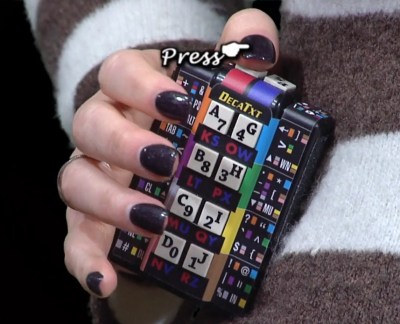Now here’s a stocking stuffer of a keyboard. The DecaTxt is the size of a deck of cards, and at first glance it looks like some kind of pocket Keno machine or other gambling or gaming apparatus. But that’s just because it’s so colorful. When you only have ten keys emulating a full keyboard, there’s bound to be some serious labeling going on, as there should be.

The DecaTxt is a Bluetooth 4.0 chording keyboard that’s meant to be used with your phone or whatever you want to pair it with. It was originally called the In10did, which stands for Input Nomenclature Ten Digit Interface Device. Catchy, no? At some point in the last ten years, this little guy went wireless and got a cooler name — the DecaTxt.
By itself, a chording keyboard isn’t that special, but this one is fairly interesting in its design. You can operate it with either one hand or two, but you’re supposed to want to use two — it was after all the In10did, not the In5did. All the chords are a maximum of three keys, so it’s not as though you need to use both hands. Some letters are accessed with a single key press, namely A through J. The rest of the alphabet uses one of the two thumb keys at the top in conjunction with the eight keys on the front. Everything else is a color-coded pair or trio of key presses away.
The idea behind this keyboard is to use your ten digits to maximum advantage, planting your thumbs on top and curling your fingers around the thing in a two-fisted, white-knuckle death grip that seems anything but ergonomic and more appropriate for, say, cracking open a coconut or separating a block of ramen into two servings. Actual users report a much better experience using it one-handed while bracing it against themselves as demonstrated in the video below. That definitely looks like the more comfortable way to go.
Ergonomic issues aside, once you learn the layout, the DecaTxt could theoretically be put into any housing and it wouldn’t matter. That is, in fact, sort of the company’s ultimate goal — to supplant QWERTY with the DecaTxt system and get it built into everything under the Sun — gloves, steering wheels, ATMs, you name it.
I think the basic idea of this keyboard is sound, and the layout could definitely be reworked into a more ergonomic housing (and probably for a lot cheaper than the $125 Bezos Barn price tag). According to the inventor, the price is so high because every DecaTxt is hand-assembled in the United States. As far as I can tell it only comes in one size, which is a bummer for people with particularly large or small hands.
I recently looked at another chording keyboard — the Infogrip BAT, which is a full keyboard with only seven keys. Both are chording keebs that do single glyphs instead of entire words, like stenography machines. The BAT is is designed for desktop use and roughly four times the size of the DecaTxt, so it’s not quite as portable, but its size and shape goes a long way toward ergonomic comfort. The DecaTxt is definitely more mobile friendly — easy to pop in a backpack — but the tradeoff is the loss of that ergonomic design.
Have you tried a chording keyboard like this one? Would you be willing to try one? How would you make it better? Here’s one you can build yourself.
No comments:
Post a Comment